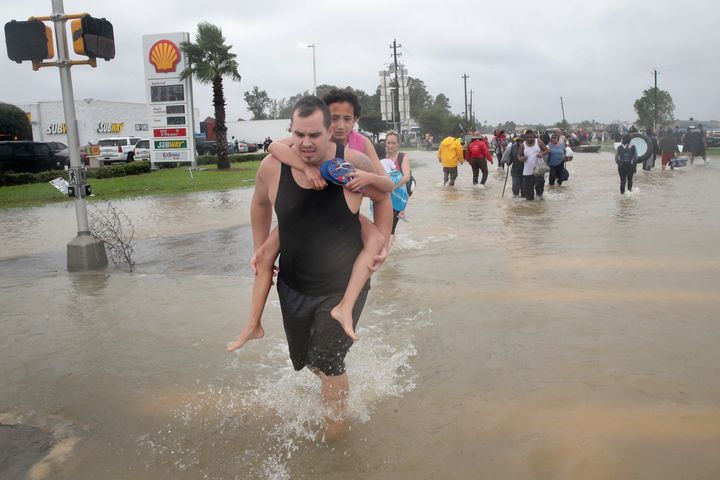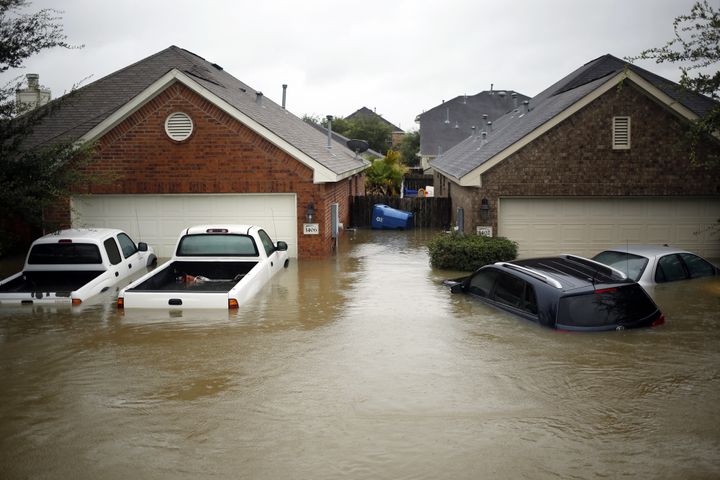Rain from the worst storm to hit the Houston region in 50 years pummelled the area again on Monday as rescue efforts continued. With water levels rising and rain from Tropical Storm Harvey predicted to continue through Thursday, officials warned of a long and difficult recovery for residents of the country’s fourth-largest city.
“We’ve got to recognise a new normal, a new and different normal for this entire region,” Republican Governor Greg Abbott said on Monday.
Here’s what you should know about the ongoing impact of the storm.

It’s already one of the worst flooding disasters in recent US history.
Since the storm made landfall on Friday evening, more than 30 inches of rain have fallen in parts of Texas, in some cases nearly doubling previous records. So much rain has drenched the state that the National Weather Service added a new colour to its maps to illustrate the intensity.
The storm has flooded highways and streets, destroyed buildings, and displaced thousands of people from their homes. As of Monday evening, more than 100,000 people in the Houston area were without power.
Brock Long, of the Federal Emergency Management Agency, predicted on Sunday that it will take years for Texas to recover from the damage. The agency expects more than 450,000 people will seek federal assistance for storm recovery, and anticipates at least 30,000 people will be displaced.
“This disaster is going to be a landmark event,” Long told CNN.
Property damage alone is expected be in the tens of billions of dollars, according to an Associated Press report. Other major economic effects will include oil refinery shutdowns, and the closure of shipping ports and airports, including Houston’s George Bush Intercontinental Airport.
The state also was threatened by toxic pollution from damaged refineries and chemical plants. Some residents of nearby communities have reported powerful odours. Authorities on Monday issued a chemical leak warning in La Porte and Shoreacres.
At least 9 people have died in the storm.
Over the weekend, at least two people were killed in storm conditions. The death toll rose on Monday, when police confirmed six people died in Harris County, and a woman in Montgomery County was killed when a tree fell on her home.
More deaths are likely to be reported in coming days, as responders have thus far focused efforts on rescuing people in life-threatening situations.

More rain is on the way.
Heavy rainfall is predicted to continue throughout the week, and some areas may receive as much as 50 inches. (For some perspective, Houston on average receives roughly 49 inches of rain annually.) Torrential rains were also expected to reach parts of Louisiana, increasing fears of flooding there.
“I want to stress that we are not out of the woods yet,” Elaine Duke, acting Department of Homeland Security secretary, said. “Harvey is still a dangerous and historic storm.”
Officials urged residents against travelling to affected areas and told them to stay off the roads as the storm continues.
As a preventative measure, the Army Corps of Engineers released water from two flood-control dams in Houston on Monday morning. That sent more water into the streets, potentially impacting thousands of residents.
Thousands of people have been rescued, and major relief efforts are underway.
Mandatory evacuations were issued in parts of several Houston-area counties, while other areas were under voluntary evacuation advisories. You can see a full list of evacuations here.
More than 3,000 people have been rescued from flooded buildings and cars by first responders. Francisco Sanchez, of Harris County’s Office of Homeland Security and Emergency Management, told HuffPost that most people in life-threatening situations have been rescued.
As Harris County was swamped by calls from residents in distress over the weekend, county Judge Ed Emme asked people with boats to aid in rescuing people trapped in their homes.
“We are asking the public to help,” Emme said. “We need you to help.”
According to Sanchez, the county now has enough resources to adequately meet rescue needs, and is only dispatching volunteer civilian boats to those not in life-threatening situations.
Medical centers were forced to take major precautions as water levels rose. Several hospitals deployed emergency flood doors intended to seal lower levels and protect patients and equipment. Ben Taub Hospital in Houston evacuated some patients, as did a Houston-area location of St. Luke’s Hospital.
Aid organisations, such as the American Red Cross, opened shelters in the Houston area to house those displaced by the storm, while Dallas’ main convention center was prepared as a “mega-shelter” that can host 5,000 evacuees.

Federal and state governments are activating emergency resources.
President Donald Trump declared a state of emergency in both Texas and Louisiana, allowing state officials access federal disaster resources. The president also said he believes Congress will pass a multi-billion dollar aid package ”very quickly.”
Abbott, meanwhile, activated the state’s entire National Guard, dispatching roughly 12,000 soldiers to help with relief efforts.
“It is imperative that we do everything possible to protect the lives and safety of people across the state of Texas as we continue to face the aftermath of this storm,” the governor said on Monday. “The Texas National Guard is working closely with FEMA and federal troops to respond urgently to the growing needs of Texans who have fallen victim to Hurricane Harvey, and the activation of the entire Guard will assist in the efforts already underway.”
The state is also setting up food and water distribution centers in affected areas.
Trump will visit Texas on Tuesday.
The president and first lady Melania Trump will travel to Corpus Christi, Texas, to visit areas impacted by the storm.
“I’ll be going to Texas tomorrow, I look very much forward to it,” Trump said on Monday. “Things are being handled really well. The spirit is incredible of the people.”
This story originally appeared on HuffPost.